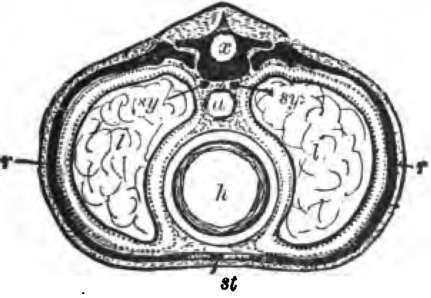The Main Nerve Centres Of The Human Body
Description
This section is from the book "The Human Body: An Elementary Text-Book Of Anatomy, Physiology, And Hygiene", by H. Newell Martin. Also available from Amazon: The Human Body.
The Main Nerve Centres Of The Human Body
The great majority of the nerve-trunks take their origin from the train and spinal cord, which together form the great ceretro-spinal centre. Some nerves, however, commence in rounded or oval masses, which vary in size from that of the kernel of an almond down to microscopic dimensions, and which are widely distributed in the body. Each of these smaller centres is called a ganglion. A considerable number of the largest ganglia are united directly to one another by nerve-trunks, and give off nerves especially to blood-vessels and to the organs in the thoracic and abdominal cavities. These ganglia and their branches form the sympathetic nervous system (Figs. 1 and 2), as distinguished from the cerebrospinal nervous system, consisting of the brain and spinal cord and the nerves proceeding from and to them.


The Gerebro Spinal Centre And Its Membranes
Lying in the skull is the brain, and in the neural canal of the vertebral column the spinal cord or spinal marrow, the two being continuous through the foramen magnum (Fig. 20) of the occipital bone. This cerebro-spinal centre consists of similar right and left halves, incompletely separated by grooves and fissures. Brain and spinal cord are very soft and easily crushed; accordingly, both are placed in almost completely closed bony cavities, and are also enveloped by membranes which give them support. These membranes are three in number. Externally is the dura mater, tough and strong, and composed of connective tissue. The innermost enveloping membrane of the cerebro-spinal centre, in immediate contact with the proper nervous parts, is the pia mater, less dense and tough than the dura mater. Covering the outside of the pia mater is a layer of flat cells; a similar layer lines the inside of the dura mater, and these two layers are described as the third membrane of the cerebro-spinal centre, called the arachnoid. In the space between the two layers of the arachnoid is a small quantity of watery cerebrospinal liquid.
To what do nerve-centres give origin? What becomes of nerve-trunks?
From what organs do most nerves arise? What is meant by the cerebro-spinal centre? From what do those nerves arise which are not directly connected with brain and spinal cord? What are the smaller nerve-centres named? What is the sympathetic nervous system ? Where is the brain placed ? What organ lies in the neural canal of the backbone? Through what opening do brain and spinal cord unite?
Why are brain and spinal cord placed in bony chambers? How many membranes also support them? What is the outside membrane named? What are its mechanical properties? Of what is it composed? What is the pia mater?
Continue to:
